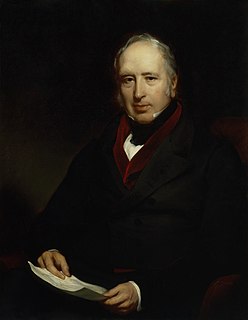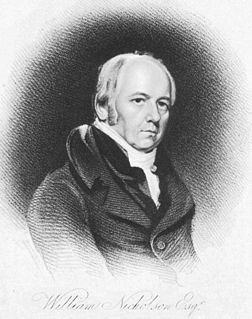
The voltaic pile was the first electrical battery that could continuously provide an electric current to a circuit. It was invented by Italian physicist Alessandro Volta, who published his experiments in 1799. The voltaic pile then enabled a rapid series of other discoveries including the electrical decomposition (electrolysis) of water into oxygen and hydrogen by William Nicholson and Anthony Carlisle (1800) and the discovery or isolation of the chemical elements sodium (1807), potassium (1807), calcium (1808), boron (1808), barium (1808), strontium (1808), and magnesium (1808) by Humphry Davy.

Sir George Cayley, 6th Baronet was an English engineer, inventor, and aviator. He is one of the most important people in the history of aeronautics. Many consider him to be the first true scientific aerial investigator and the first person to understand the underlying principles and forces of flight and the first man to create the wire wheel.

Jean-André Deluc or de Luc was a Swiss geologist, natural philosopher and meteorologist. He also devised measuring instruments.

Friedrich Christian Accum or Frederick Accum was a German chemist, whose most important achievements included advances in the field of gas lighting, efforts to keep processed foods free from dangerous additives, and the promotion of interest in the science of chemistry to the general populace. From 1793 to 1821 Accum lived in London. Following an apprenticeship as an apothecary, he opened his own commercial laboratory enterprise. His business manufactured and sold a variety of chemicals and laboratory equipment. Accum, himself, gave fee-based public lectures in practical chemistry and collaborated with research efforts at numerous other institutes of science.

William Sturgeon was an English physicist and inventor who made the first electromagnets, and invented the first practical British electric motor.

Giovanni Battista Venturi was an Italian physicist, savant, man of letters, diplomat and historian of science. He was the discoverer of the Venturi effect, which was described in 1797 in his Recherches Experimentales sur le Principe de la Communication Laterale du Mouvement dans les Fluides appliqué a l'Explication de Differens Phenomènes Hydrauliques, translated into English by William Nicholson as "Experimental Inquiries Concerning the Principle of the Lateral Communication of a Motion in Fluids," and published in 1836 in Thomas Tredgold's Tracts on Hydraulics. Because of this discovery, he is the eponym for the Venturi tube, the Venturi flow meter and the Venturi pump.

William Nicholson was an English writer, translator, publisher, scientist, inventor, patent agent and civil engineer. He launched the first monthly scientific journal in Britain, Journal of Natural Philosophy, Chemistry, and the Arts, in 1797, and remained its editor until 1814. In 1800, he and Anthony Carlisle were the first to achieve electrolysis, the splitting of water into hydrogen and oxygen, using a voltaic pile. Nicholson also wrote extensively on natural philosophy and chemistry
William George Horner was a British mathematician. Proficient in classics; mathematics, he was a schoolmaster, headmaster and schoolkeeper, who wrote extensively on functional equations, number theory and approximation theory, but also on optics. His contribution to approximation theory is honoured in the designation Horner's method, in particular respect of a paper in Philosophical Transactions of the Royal Society of London for 1819. The modern invention of the zoetrope, under the name Daedaleum in 1834, has been attributed to him.

Thomas Thomson MD was a Scottish chemist and mineralogist whose writings contributed to the early spread of Dalton's atomic theory. His scientific accomplishments include the invention of the saccharometer and he gave silicon its current name. He served as president of the Philosophical Society of Glasgow.

The Philosophical Magazine is one of the oldest scientific journals published in English. It was established by Alexander Tilloch in 1798; in 1822 Richard Taylor became joint editor and it has been published continuously by Taylor & Francis ever since.

Richard Taylor was an English naturalist and publisher of scientific journals. He became joint editor of the Philosophical Magazine in 1822 and went on to publish the Annals of Natural History in 1838. He edited and published Scientific Memoirs, Selected from the Transactions of Foreign Academies of Science from 1837 to 1852. In 1852, he was joined by the chemist, Dr William Francis to form Taylor and Francis.

The Journal of Natural History is a scientific journal published by Taylor & Francis focusing on entomology and zoology. The journal was established in 1841 under the name Annals and Magazine of Natural History and obtained its current title in 1967. The journal was formed by the merger of the Magazine of Natural History (1828–1840) and the Annals of Natural History and Loudon and Charlesworth's Magazine of Natural History.

The Surrey Institution was an organisation devoted to scientific, literary and musical education and research, based in London. It was founded by private subscription in 1807, taking the Royal Institution, founded in 1799, as a model. The Institution lasted only until 1823, when it was dissolved.

Sir Henry Charles Englefield, 7th Baronet FRS FRSE FSA FLS was an English antiquary and astronomer.
Sir William Cecil Dampier FRS was a British scientist, agriculturist, and science historian who developed a method of extracting lactose from whey.

Alexander Tilloch FSA (Scot) was a Scottish journalist and inventor. He founded the Philosophical Magazine.
Annals of Philosophy; or, Magazine of Chemistry, Mineralology, Mechanics, Natural History, Agriculture and the Arts was a learned journal founded in 1813 by the Scottish chemist Thomas Thomson. It shortly became a leader in its field of commercial scientific periodicals. Contributors included John George Children, Edward Daniel Clarke, Philip Crampton, Alexander Crichton, James Cumming, John Herapath, William George Horner, Thomas Dick Lauder, John Miers, Matthew Paul Moyle, Robert Porrett, James Thomson, and Charles Wheatstone.
Robert Porrett (1783–1868) was an English amateur chemist and antiquary.

Eric R. Scerri is a chemist, writer and philosopher of science of Maltese origin. He is a lecturer at the University of California, Los Angeles; and the founder and editor-in-chief of Foundations of Chemistry, an international peer reviewed journal covering the history and philosophy of chemistry, and chemical education.

Sir George Smith Gibbes M.D. (1771–1851) was an English physician and writer.
















